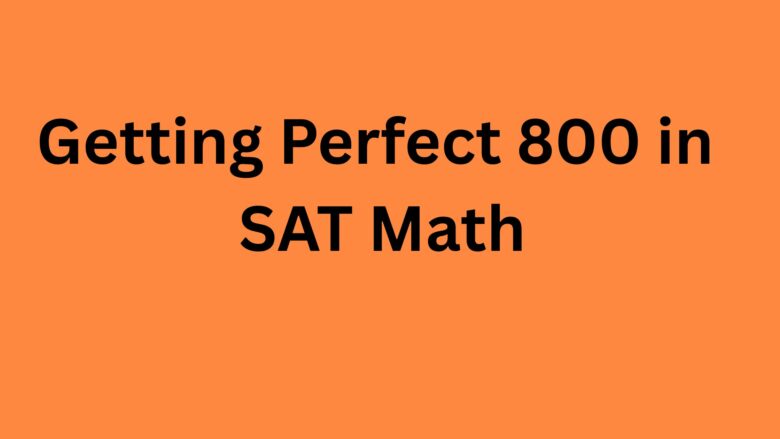Guidelines for Achieving a Top Score of 800 in Math on the SAT
Proven Strategies for Top Performance
Getting a perfect 800 in SAT Math demonstrates that someone has mastered how to think, reason, and solve problems in math. Now that the Digital SAT is fully implemented, it is more important than ever to know how the sections are organized and to make an appropriate strategy. This guide explains the best strategies for reaching a top SAT Math score and also introduces how Noble Learners can help you along the way.
Be aware of the type of Digital SAT Math Format that will be used
There are two computer-adaptive modules that make up the new Digital SAT Math section:
- Module 1: The test will have 22 questions from different difficulty levels.
- Module 2: The number of questions you have to answer will depend on how well you did in the first module.
There are 35 minutes for each module, totaling in 70 minutes. While the paper test limits calculators, the math section during the online test now allows you to use calculators, including Desmos.
Key Topics Covered:
- Algebra (linear equations, systems, inequalities)
- Advanced Math (functions, quadratics, exponentials)
- Data analysis (ratios, percentages, statistics) and solving different types of problems
- Geometry focuses on angles, volumes, and the key properties of triangles, and Trigonometry does the same.
It is important to have a clear understanding of the topics and stay accurate in every area, as this will mainly benefit Module 2.
Build Strong Math Fundamentals
While SAT Math focuses on math used in the real world, you should also make sure you grasp the key math foundations:
- Master algebraic manipulation
- Be able to study how functions behave both in graphs and tables
- Handle working with percentages, ratios, and proportions easily
- Memorize key geometry formulas
- Practice turning hard word problems into smaller and easier problems
Having a firm understanding helps you deal with the basics more quickly and allows you to focus more on tougher questions.
Focus on High-Yield Concepts
There are differences in the levels of difficulty of certain math subjects. Focus on areas that cover a lot of possible questions and that matter a lot in term test scores, such as:
- Linear and quadratic equations
- Exponential growth and decay
- Systems of equations and inequalities
- Graphing and interpreting functions
- Statistics: mean, median, mode, and probability
Pay attention to which types of questions are included most in the College Board’s practice materials, as those are the first ones you should focus on.
Practice with Adaptive Digital Tools
The Digital SAT is adaptive. In other words, the difficulty of the second module will be affected by your performance in the first one. To adapt to this structure:
- Try to use Bluebook, the official College Board app, to experience taking the test just like in real life
- Try solving tests for the full amount of time they will be given in a digital format
- Watch out for the flow of the questions and how speedily the game changes from one to another
- Avoid making simple mistakes in Module 1 to get access to the more challenging exercises in Module 2
Using Desmos and Khan Academy, you can try out different ways to solve problems using digital devices and calculators.
Eliminate Careless Errors
Most of the time, it is little, easy-to-avoid errors that hold someone back from a perfect score:
- Misreading word problems
- Skipping steps
- Rushing calculations
- Failing to double-check answers
Combat these by:
- Writing how to solve even the simple problems
- Emphasizing the main parts of the information in word problems
- Checking over grid-in answers to make sure they are correct
- Take the final five minutes to read over any questions that need your attention
Make sure to use the Desmos Graphing Calculator in the right way
As part of the Digital SAT, you have access to Desmos:
- You can create graphs and check the intercepts with it
- Solutions to complex math problems or polynomials can be checked also
- Make sure to double-check your findings, don’t fully depend on it for accuracy
- Spend some time getting to know the layout and everything you can do on the site
Practice Test for an Entire Duration
Like running a marathon, reaching 800 needs you to have endurance. Simulate the real test:
- Complete at least four full-length digital versions of the SAT ahead of your test day
- Keep track of how far you have come and see where you tend to make mistakes
- Mimic real test conditions: quiet space, timer, Bluebook app
In turn, you will be able to handle pressure, manage your time, and increase your ability to stick to the task.
Participate in Discussions with Expert Noble Learners
For many students who score well, doing extra study isn’t the only thing that helps them succeed. Through Noble Learners, students are able to get premium tutoring for the Digital SAT exam.
With Noble Learners, you get:
- Learning plans that are created based on the outcome of diagnostic tests
- Tutors who are knowledgeable in SAT Math and offer advice on the best test strategy
- Private lessons for the most challenging parts of the course and analyzing errors
- Confirmed proof that students who scored between 750–800 saw a dent in poverty
If you are either new to online testing or have hit a pause in your progress, Noble Learners can help guide you to a higher score.
Visit: www.noblelearners.in
